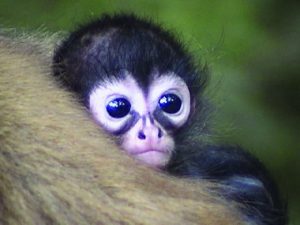Spider monkeys are found in the tropical forests of Central and South America ranging from southern Mexico, to Colombia, to Brazil. They are known for their long limbs and extremely flexible tails, which they mainly use for climbing and balance. Out of the New World monkeys, they are considered the most intelligent for their communication and memorization skills. They are capable of emitting a large range of sounds and postures either for warding off predators or for selecting a potential mate. Their frugivorous diet also drives them to recall a wide variety of plants in which they can consume. When fruit is not available, they will resort to leaves, flowers, insects, honey, and bark.

Colombian spider monkeys form groups of 15 to 25 normally, however during the day they will separate into 2 to 8 monkeys per subgroup. The size of the subgroup depends on food competition and risk of predation. A female monkey will part from her family during puberty rather than a male, who will become dependent and form groups with his other male relatives. The female will form her own close bonds through her offspring.
Spider monkeys are diurnal, meaning that they spend the night sleeping in carefully chosen trees and the day searching for food which is led by the female. The females are responsible for planning what route to take during feeding time. If there are not enough sources for the entire group, the spider monkeys will split up into smaller sub-groups.
Did you know?
A Colombian spider monkey’s tail contains a hairless tip with tiny skin grooves that is similar to fingerprints.







